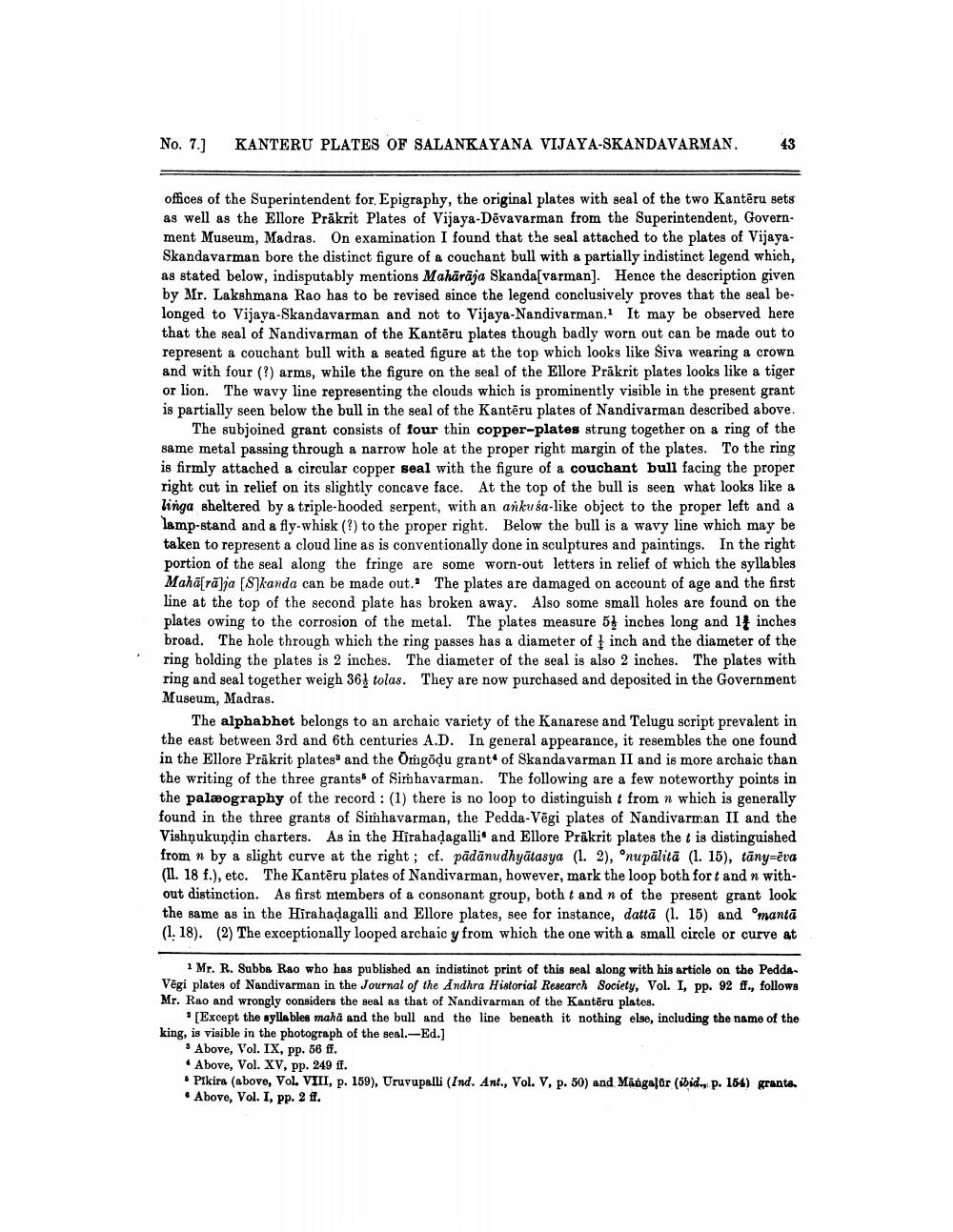________________
No. 7.)
KANTERU PLATES OF SALANKAYANA VIJAYA-SKANDAVARMAN.
43
offices of the Superintendent for. Epigraphy, the original plates with seal of the two Kantēru sets as well as the Ellore Präkrit Plates of Vijaya-Dévavarman from the Superintendent, Government Museum, Madras. On examination I found that the seal attached to the plates of VijayaSkandavarman bore the distinct figure of a couchant bull with a partially indistinct legend which, as stated below, indisputably mentions Mahārāja Skandas varman). Hence the description given by Mr. Lakshmana Rao has to be revised since the legend conclusively proves that the seal belonged to Vijaya-Skandavarman and not to Vijaya-Nandivarman. It may be observed here that the seal of Nandivarman of the Kantēru plates though badly worn out can be made out to represent a couchant bull with a seated figure at the top which looks like Siva wearing a crown and with four (?) arms, while the figure on the seal of the Ellore Prākrit plates looks like a tiger or lion. The wavy line representing the clouds which is prominently visible in the present grant is partially seen below the bull in the seal of the Kantēru plates of Nandivarman described above.
The subjoined grant consists of four thin copper-plates strung together on a ring of the same metal passing through a narrow hole at the proper right margin of the plates. To the ring is firmly attached a circular copper seal with the figure of a couchant bull facing the proper right cut in relief on its slightly concave face. At the top of the bull is seen what looks like a linga sheltered by a triple-hooded serpent, with an anku sa-like object to the proper left and a lamp-stand and a fly.whisk (?) to the proper right. Below the bull is a wavy line which may be taken to represent a cloud line as is conventionally done in sculptures and paintings. In the right portion of the seal along the fringe are some worn-out letters in relief of which the syllables Mahā rā]ja [S]kanda can be made out. The plates are damaged on account of age and the first line at the top of the second plate has broken away. Also some small holes are found on the plates owing to the corrosion of the metal. The plates measure 54 inches long and 14 inches broad. The hole through which the ring passes has a diameter of 1 inch and the diameter of the ring holding the plates is 2 inches. The diameter of the seal is also 2 inches. The plates with ring and seal together weigh 36 tolas. They are now purchased and deposited in the Government Museum, Madras.
The alphabhet belongs to an archaic variety of the Kanarese and Telugu script prevalent in the east between 3rd and 6th centuries A.D. In general appearance, it resembles the one found in the Ellore Prākrit plates and the Omgõdu grant of Skandavarman II and is more archaic than the writing of the three grants of Simhavarman. The following are a few noteworthy points in the palæography of the record : (1) there is no loop to distinguish t from n which is generally found in the three grants of Simhavarman, the Pedda-Vēgi plates of Nandivarman II and the Vishnukundin charters. As in the Hirahadagalli and Ellore Präkrit plates the t is distinguished from n by a slight curve at the right; cf. pādānudhyātasya (1.2), "nupālitā (1. 15), tāny=ēva (11. 18 f.), etc. The Kantēru plates of Nandivarman, however, mark the loop both fort and n without distinction. As first members of a consonant group, both t and n of the present grant look the same as in the Hirahadagalli and Ellore plates, see for instance, dattă (1. 15) and Omantā (1.18). (2) The exceptionally looped archaic y from which the one with a small circle or curve at
1 Mr. R. Subba Rao who has published an indistinot print of this seal along with his article on the PeddaVégi plates of Nandivarman in the Journal of the Andhra Historial Research Society, Vol. I, pp. 92 ff., follows Mr. Rao and wrongly considers the seal as that of Nandivarman of the Kantēru platos.
[Except the syllables maha and the bull and the line beneath it nothing else, including the name of the king, is visible in the photograph of the seal.--Ed.]
* Above, Vol. IX, pp. 56 ff. * Above, Vol. XV, pp. 249 ff. . Pikira (above, VOL. VIII, p. 159), Uruvupalli (Ind. Ant., Vol. V, p. 50) and Mangalur (ibid., p. 164) grants. . Above, Vol. I, pp. 2 ff.




